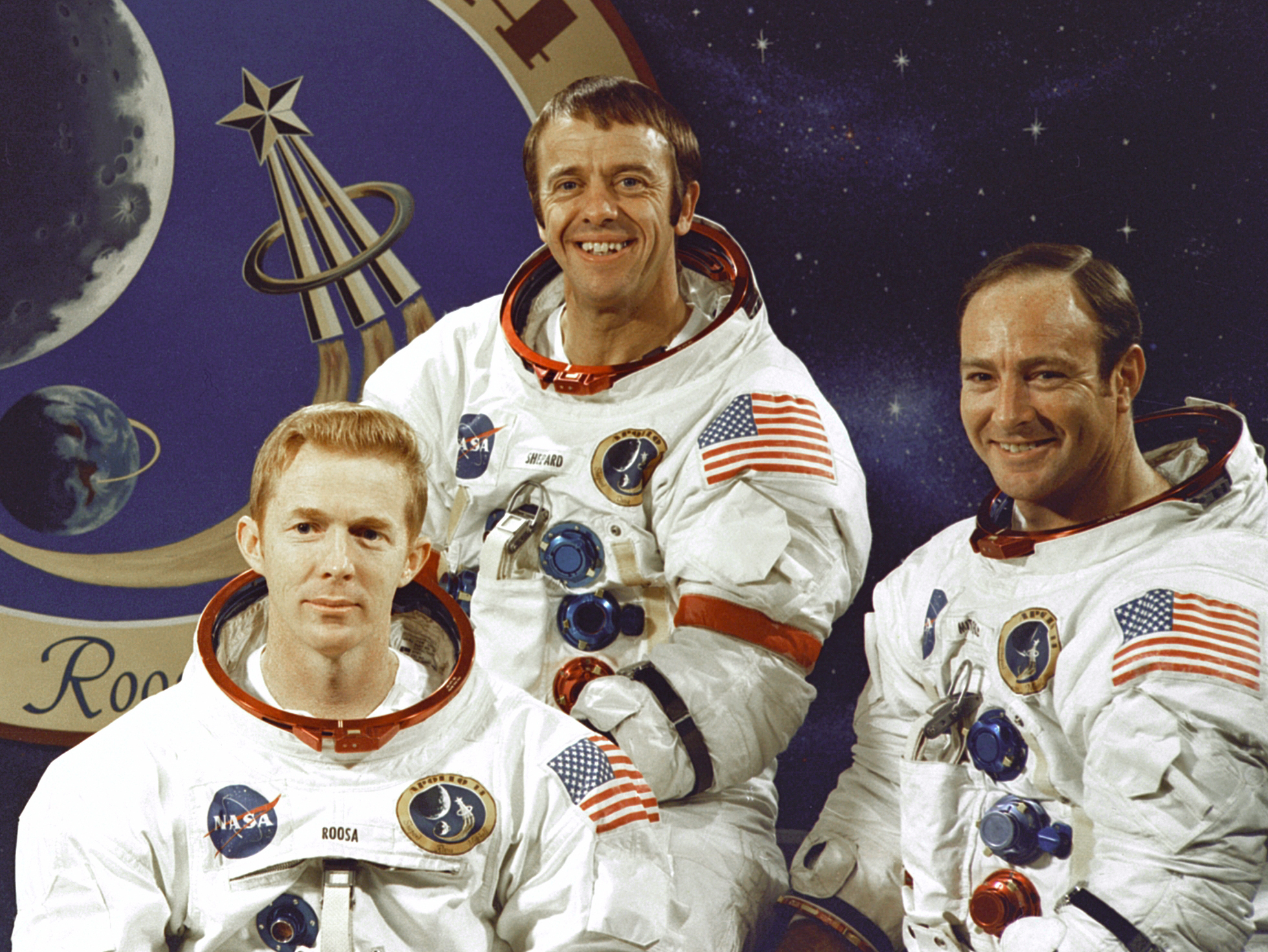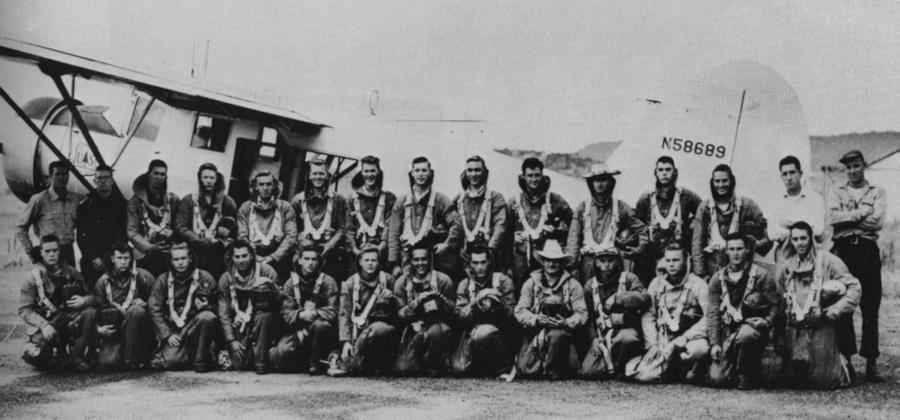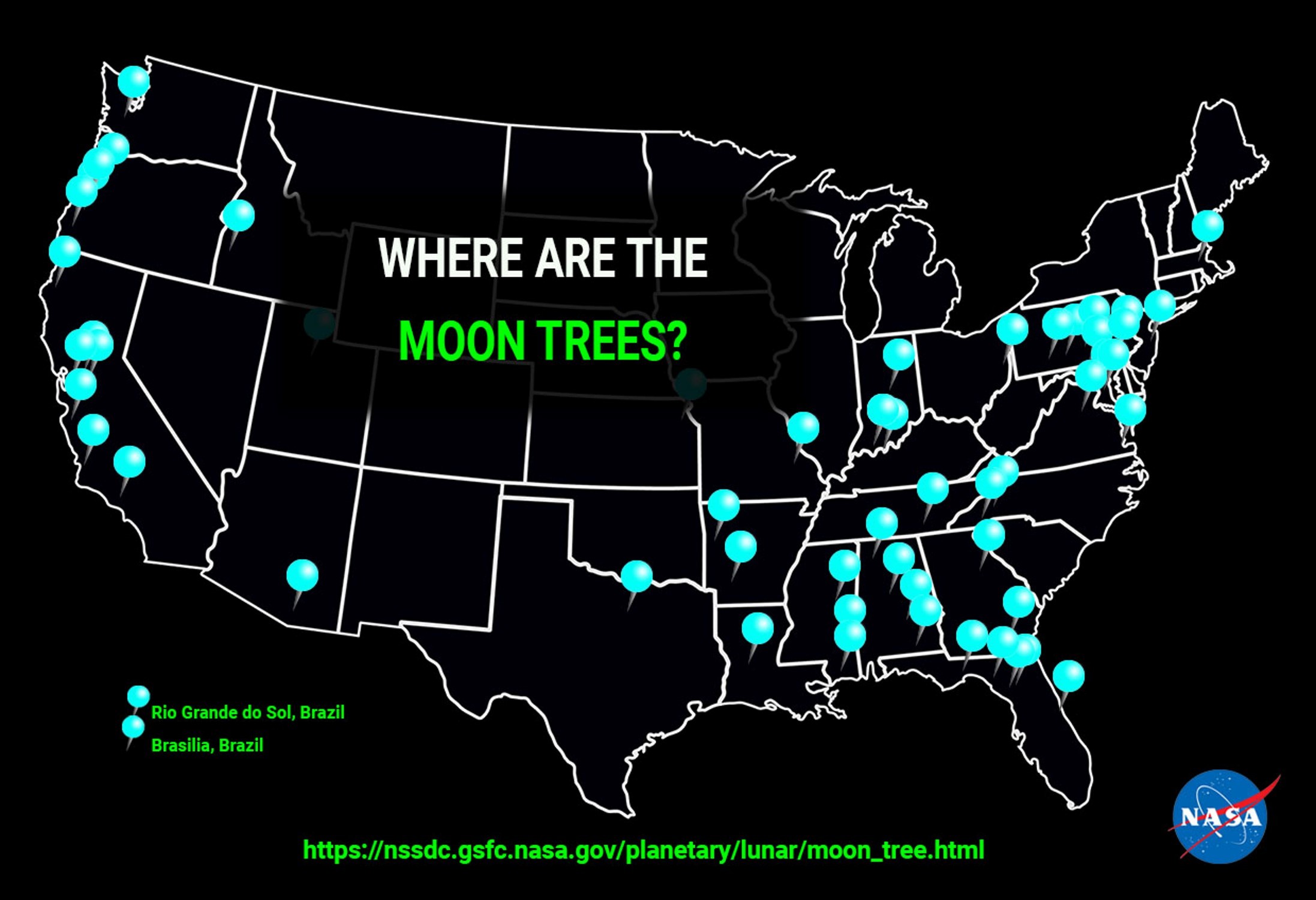
To me, the best virtual caches show you something hiding in plain sight that you just never noticed. This virtual geocache highlights an object unique in the United States and, quite possibly, the last one of its kind in the world - a Moon Tree! This cache is in a Loudon County park, so ABSOLUTELY NO NIGHT CACHING!!!
Moon Trees: The Birth of an Idea
In April, 1966, NASA selected Astronaut Group 5, including Stuart "Stu" Roosa and Edgar Mitchell. As crews were chosen for the Apollo flights, Roosa and Mitchell were to be joined by Alan Shepard, the first American in space and one of the original Mercury 7 astronauts, as the prime crew for Apollo 13. Instead, they became the prime crew for Apollo 14 (Jan. 31-Feb. 9, 1971), with Roosa as Command Module Pilot who would stay in orbit, with Mitchell and Shepard walking on the Moon.

Crew of Apollo 14 - (L to R) Roosa, Shepard, Mitchell
Thirteen years before Stu Roosa made 34 orbits of the Moon in the Apollo 14 Command Module Kitty Hawk, he was a member of the smokejumper class of 1953. He was based in Siskiyou County in northern California and made four jumps into active fires.

Smokejumper class of 1953. Stu Roosa is standing, 4th from left
Ed Cliff, Chief of the US Forest Service (USFS), knew of Roosa from his days as a smokejumper and proposed a collaborative USFS-NASA project to fly tree seeds to the Moon. Dr. Stan Krugman, a USFS geneticist, was put in charge of the project, harvesting seeds of Douglas Fir from Oregon and California, Coast Redwood from California, Loblolly Pine from Louisiana and Virginia, Sweetgum from North Carolina, and Sycamore from Mississippi. Approximately 2000 seeds were sealed in a cylindrical metal container (shown with Stu Roosa at the top of this description) and flown in Roosa's personal gear bag. A variety of explanations are offered for why the experiment was conducted, ranging from honoring the importance of forests in America's past and future to understanding the effects of radiation on tree seeds, but Krugman joked "It was part science, part public relations".
The return to Earth
Upon their return, the seeds were turned over to Dr. Charles Walkinshaw of the US Dept of Agriculture, who was on detail with NASA. The seeds were subject to decontamination, even as the astronauts became the last Apollo crew subject to isolation. During their decontamination, the seed containers burst, exposing the seeds to vaccuum. Technicians gathered the seeds and sent them to Dr. Krugman, who sorted them by hand. Dr. Walkinshaw then germinated a large number of seeds, although inadequate facilities and delays resulted in few, if any, seedlings surviving. The remaining seeds were sent to Forest Service stations in Placerville, CA (Douglas Fir and Coast Redwood) and Gulfport, MS (Loblolly Pines, Sycamore, and Sweetgums), where better facilities produced viable seedlings. Seedlings were made available in 1975 and many were planted for the US Bicentennial. Records are incomplete as to how many seedlings were distributed, but suggest distribution to 40 states and 3 foreign countries. 118 Moon Tree locations are known, including 64 locations for living trees in the US. Locally, the Moon Tree planted at the White House did not survive. Some trees were planted outside their natural range (e.g., sycamores in New Mexico and Arizona) with mixed results.

Loudon County's Moon Tree
Dr. Krugman gave a sickly Sweetgum sapling to R. Max Peterson, Deputy Chief of the Forest Service and a resident of Leesburg. Mr. Peterson managed to nurse it back to health. It was planted in its current location around September of 1978. Its growth was somewhat slowed at 8-10 feet tall, as the deer had a tendency to rub their horns on it. Today, the tree stands approximately 60 feet in height and is thriving. It may be the last remaining Sweetgum Moon Tree. In late 2023, two Sweetgums growing in Tell City, IN, after years of declining health, were cut down. The health of a single Sweetgum planted in Brazil is unknown. These are the only four Sweetgum Moon Trees documented. It is unclear if few germinated and grew to seedlings or if they simply weren't requested.
How the Moon Tree came to be part of Scott Jenkins Memorial Park is an interesting story in itself. Accounts vary as to whether Mr. Peterson planted the tree when he owned this plot of land or whether it was the land of a family friend, but it has remained at this location since it was planted in 1978. The Moon Tree was threatened at some point by Virginia Power's plan to clear land for transmission lines along Route 7. Mr. Peterson alerted Virginia Power to the existence of the Moon Tree and the lines were re-routed. In 2008, the Virts family offered a partial donation/partial purchase of the land containing the Moon Tree to Loudon County to establish a park named after their nephew Scott Jenkins, who died in a jet ski accident at 18. Recognizing the significance of the Moon Tree, Loudon County parks preserved the small grove of trees and fenced off the Moon Tree with both a decorative wooden fence and a wire mesh fence to deter deer. Mr. Peterson passed away in 2014, having seen his Moon Tree become a public treasure for Loudon County.

R. Max Peterson in 2005 with the Moon Tree he planted in 1978.
Logging Requirements
Please read carefully so your log isn't deleted! Reminder: ABSOLUTELY NO NIGHT CACHING!!!
1) Visit the posted coordinates (at the end fence post of the wooden fence) and post a picture with the Sweetgum Moon Tree. Do not enter the wire fence! The photo MUST include an object (e.g., piece of paper, personalized object) with the geocaching name for EVERY geocacher logging this virtual cache. Including yourself in the photo is welcome, but not required. If you are unclear about identifying a Sweetgum tree, it has distinctive leaves in Spring and Summer and seedpods (often called gumballs) in Fall and Winter. The Moon Tree is at the approximate center of the wire mesh fence. Logs that do not include this photo will be deleted. Please be sure to have a sign with your name or the supplies to produce one when you visit the cache. If you are physically unable to climb the small hill to access this space, I will accept another location, as long as it clearly shows the Sweetgum Moon Tree AND an item with your geocaching name in the posted photo.

2) Visit the waypoint with the information sign. Please note that the Sweetgum Moon Tree is NOT directly visible from this sign. Send the CO a message (do not post in your log or post a photo of the sign) with the following information: What year did Mr. Peterson retire from the US Forest Service? What position did he hold at that time? What logos are found in the lower right hand corner of the sign?
Optional: An Adventure Lab highlighting the Moon Trees of the National Capital Region is being published at the same time as this Virtual geocache. If you would like to extend your experience beyond just this Moon Tree, you'll visit a Sycamore at Goddard Space Flight Center, a Loblolly Pine at the former home of the Society of American Foresters, and a 2nd generation (half Moon) Sycamore and the grave site of Stu Roosa at Arlington National Cemetery. No bonus cache is associated with the Adventure Lab.
Virtual Rewards 4.0 - 2024-2025
This Virtual Cache is part of a limited release of Virtuals created between January 17, 2024 and January 17, 2025. Only 4,000 cache owners were given the opportunity to hide a Virtual Cache. Learn more about Virtual Rewards 4.0 on the Geocaching Blog.